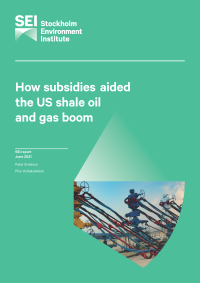How subsidies aided the US shale oil and gas boom

This analysis looks at the last two decades of investment data for US oil and gas fields to evaluate how major federal subsidies may have played a role in the huge boom in US oil and gas production. It finds that federal subsidies amplified the expected financial returns of investing in unconventional oil and gas development, thereby helping to spur and sustain the US shale boom over the last two decades.
In particular, the analysis estimates that two tax incentives alone – the expensing of intangible drilling costs and percentage depletion provisions – increased the expected value of new oil and gas projects by billions of dollars in most years and by over $20 billion in certain high-price years. This translates to a median increase in expected value of $4 per barrel of oil equivalent or more for projects in those high-price years (2008 and 2010–2014).
Researchers also found that subsidies added substantial value to new oil and gas projects considered during the shale booms in the Bakken Formation in 2005–2006, the Appalachian and Haynesville regions in 2008, the Eagle Ford play in 2009–2010 and the Permian basin in 2011–2015. This is when subsidies provided the most overall value, but it is likely that subsidies made the most difference to prospective new projects at other times, including when prices were low and new projects were therefore more marginal. Many oil projects in 2016 were marginal (and subsidy-dependent), as were many gas projects in Appalachia in 2010–2012.
- Erickson, P. and Achakulwisut, P. (2021). How subsidies aided the US shale oil and gas boom. SEI report.

